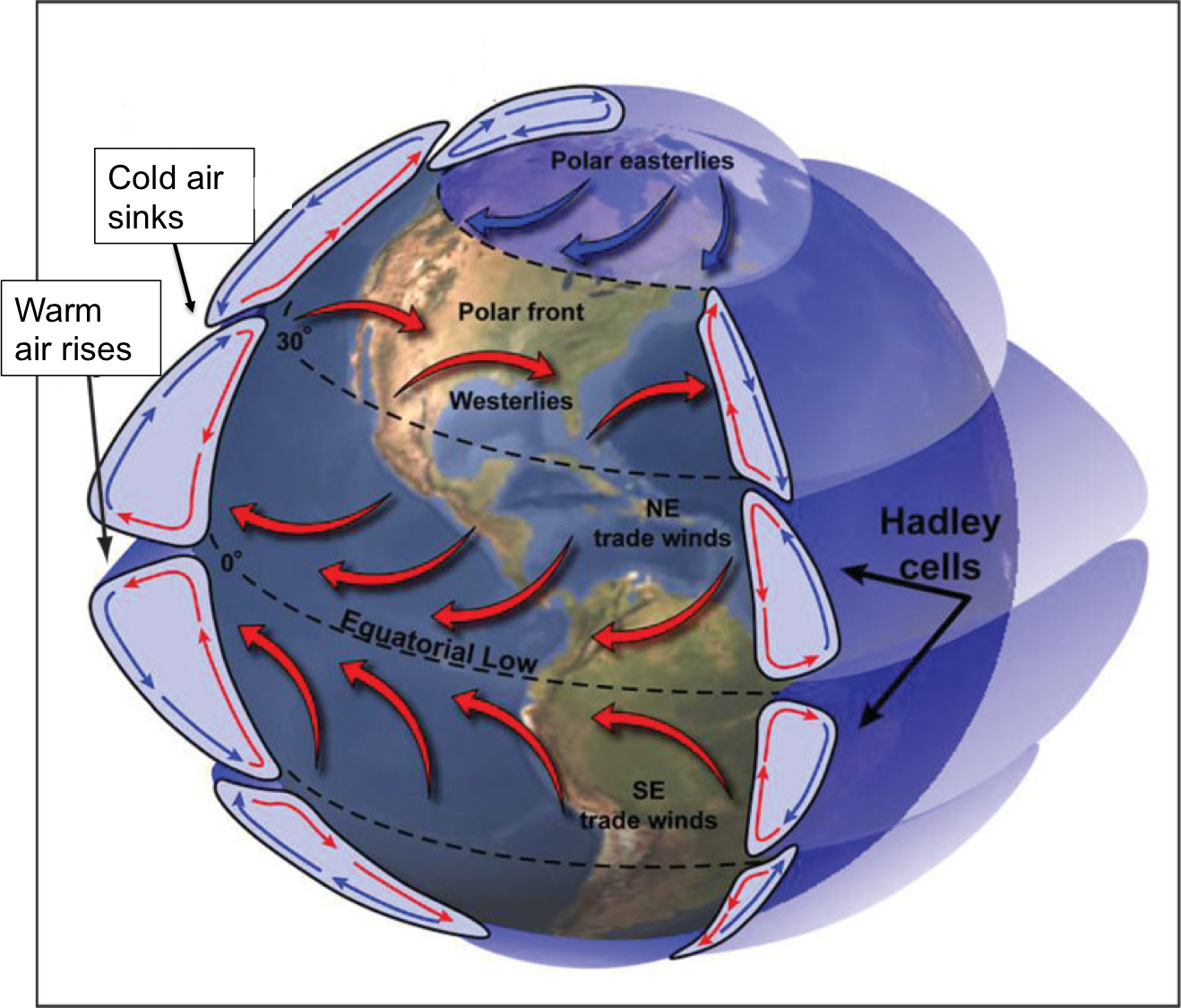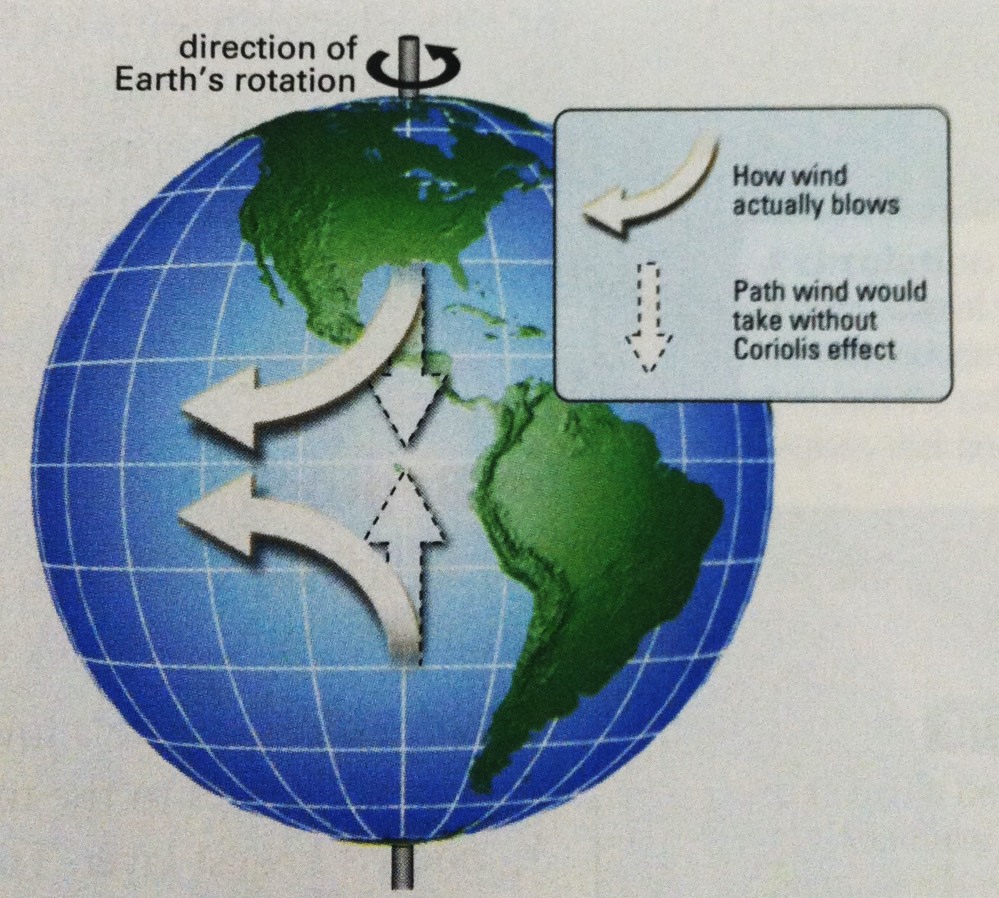Ocean Currents
How are Ocean Currents Formed?
Winds
- Wind is the primary force driving surface currents in the ocean. The sun heats the surface of the earth unevenly because of the shape and tilt of the earth. Warm air masses form where the sun’s radiation is most intense, which is at the equator. Cold air masses form at the poles, where the sun’s radiation is less intense. Warmer air masses rise into the atmosphere, creating areas of low pressure. As air masses cool high in the atmosphere, they sink and create areas of high pressure. The rising and sinking of air masses in the earth’s atmosphere create winds.
- Rising warm, moist air at the equator travels northward and southward, cooling as it moves towards the poles. When this air reaches a certain cold temperature and density (at about 30 degrees N and S latitude), it sinks and creates an area of high pressure.
- Where the air sinks, some travels towards the pole and some air travels towards the equator. This air motion creates strong winds flowing from the west (“westerlies”, see below) and the northeast (trade winds, see below) in the Northern Hemisphere. These dominant wind patterns drive oceanic currents (see below).

Source: www.southwestclimatechange.org
The Coriolis Effect
- If the earth did not rotate, rising air at the equator and sinking air at higher latitudes would move straight from the poles to the equator. In reality, the air moves in a curved direction relative to the surface of the earth as it flows (creating winds in westerly and northeasterly directions) because the earth is rotating beneath the air. Imagine that you are strong enough to throw a ball from New England to Costa Rica. The ball would travel in a straight line, but the earth rotates beneath the path of the ball. Because of this, it would appear that the ball moves to the right relative to the surface of the earth, when really the earth is moving relative to the path of the ball.
- This is known as the Coriolis effect, and explains why air, once set in motion in the atmosphere, deflects to one side as it moves.
- Because of the direction of earth’s rotation, the Coriolis effect causes objects to move to the right in the Northern hemisphere and the left in the Southern hemisphere (oceanservice.noaa.gov, www.seos-project.eu).
- The Coriolis effect deflects air to the east as it flows towards the poles and towards the west as it flows towards the equator in the northern hemisphere. These deflected winds are known as “westerlies” and “northeasterly trade winds.”
The Coriolis effect causes air and water to move towards the right in the northern hemisphere and the left in the southern hemisphere (source: http://storliea.edublogs.org/)
- Water set in motion by the wind is also deflected to the right in the Northern hemisphere and the left in the Southern hemisphere. At the surface in the Northern Hemisphere, water is transported at a net angle of 90 degrees to the right of the prevailing wind direction. This phenomenon is known as Ekman Transport, and is an important concept for understanding coastal upwelling and downwelling.
Gyres
- The motion of the winds and deflection of water towards the right (northern hemisphere) and left (southern hemisphere) of the prevailing wind directions generates large circular current systems in the world’s oceans known asgyres.
- Deflection of water towards the center of the gyre due to the Coriolis effect causes water to “pile up” in the center of the gyre, creating an area of slightly higher elevation on the surface of the ocean. Gravity then pulls the water back down the slope to an area of lower elevation, fueling further rotation of the gyre.
- Currents along the western side of gyres are called western boundary currents, while currents along the eastern side of gyres are called eastern boundary currents. The westerly flowing currents that are created where the North Pacific and South Pacific gyres meet are known as the equatorial currents (oceanservice.noaa.gov, www.seos-project.eu).
- Western boundary currents flow deeper and stronger than eastern boundary currents. This means that cool, nutrient-rich water is closer to the surface in eastern boundary currents than western boundary currents. This results in the creation of rich upwelling zones in areas with eastern boundary currents, such as the California Current.

Source: http://www.cmmap.org/
How Currents Are Measured
- Passively drifting buoys (called drifters) are deployed in the ocean. Drifters may be deployed at the surface of the ocean or at a particular depth. These drifters contain GPS devices that record their position through time, transmitting this information to orbiting satellites. Drifters also often have other sensors that measure things such as temperature and salinity.
- Scientists also use instruments attached to anchored buoys or mounted onshore to measure currents. These instruments are called Acoustic Doppler Current Profilers (ADCPs), and use sound waves to measure the motion of particles in the water.


